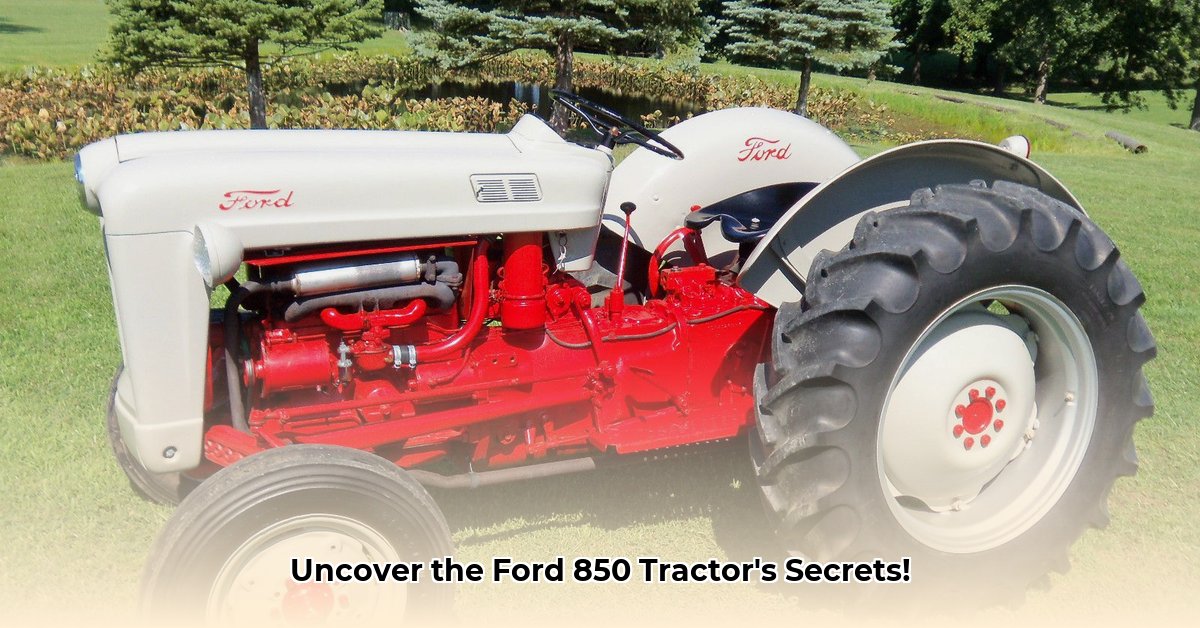
Power Under the Hood: Understanding the Ford 850's Capabilities
The Ford 850 tractor, a symbol of mid-20th-century agricultural mechanization, offered farmers a reliable, albeit less powerful, workhorse for its time. Manufactured between 1954 and 1957, its 2.8-liter gasoline engine delivered approximately 40 horsepower—a respectable output for the era. Farmers also had the option of an LP gas engine, showcasing the emerging interest in alternative fuels. However, its five-speed unsynchronized transmission required skilled shifting, a stark contrast to today's smoother, synchronized counterparts. The 14-gallon fuel tank provided a reasonable operational range, although fuel consumption varied depending on tasks and terrain conditions. How did this power and fuel efficiency compare to competitors? For more information on larger Ford tractors, check out the Ford 1000 information. Further investigation into contemporaneous models is warranted to fully establish its position within the market.
Ford 850 Tractor Specs: A Detailed Overview
This table summarizes the key specifications of the Ford 850 tractor. Note that minor variations may exist due to manufacturing differences.
| Specification | Value | Notes |
|---|---|---|
| Engine | 2.8L Gasoline | LP Gas option available; carburetor variations existed |
| Horsepower | Approximately 40 hp | Estimates vary; testing methodologies differed. |
| Transmission | 5-speed Unsynchronized | Required skillful shifting; lacked modern synchronizers. |
| Fuel Capacity | 14 gallons | Range varied depending on workload and terrain. |
| Production Years | 1954-1957 | Over 200,000 units were produced. |
| Manufacturing Location | Highland Park, MI | Representative of American manufacturing of the era. |
A Tractor's Tale: The Ford 850 in Historical Context
The Ford 850 emerged during a pivotal era in agriculture, a time of rapid mechanization. Farmers were transitioning from animal-powered farming to the efficiency of tractors. The Ford 850, with its relatively affordable price and dependable performance, became a popular choice, accelerating this crucial shift towards mechanized agriculture. While not the most powerful model available, its reliability and accessibility made it a significant player in shaping farming practices. This tractor serves as a vital link in the evolution from horse-drawn implements to the sophisticated machinery of today. Did its popularity stem solely from price and reliability, or were there other contributing factors?
Sustainability: A Modern Perspective on a Classic Machine
Evaluating the Ford 850's environmental impact requires considering its historical context. Gasoline, its primary fuel, is not considered environmentally friendly by today's standards, and emission regulations were significantly less stringent than they are now. However, comparing its fuel efficiency to contemporary tractors offers valuable insights. Did it, in fact, offer fuel economy comparable to or surpassing competing models? This warrants deeper investigation into available data for a conclusive assessment. Further analysis of the fuel efficiency of gasoline versus LP gas models would also add valuable context to this historical analysis.
Comparing Ford 850 Fuel Efficiency to Modern Alternatives
Key Takeaways:
- The Ford 850's fuel efficiency pales in comparison to modern tractors.
- Its fuel consumption provides valuable context for understanding agricultural advancements.
- Direct comparison is challenging due to significant technological advancements.
- Analyzing its design illustrates the trade-offs between power and fuel economy in its era.
The Ford 850, while a workhorse of its time, lacked the fuel efficiency of modern tractors, reflecting the technological and environmental priorities of its era. The tractor's mechanical design and reliance on gasoline—a less fuel-efficient choice compared to modern diesel options—contributed to higher fuel consumption. This difference is not simply a matter of numbers; it underscores a fundamental shift in agricultural priorities. Modern agricultural practices emphasize fuel economy, emission reduction, and environmental responsibility, which were not primary concerns during the Ford 850's era of production. How might a modern, sustainable redesign of the Ford 850 address these concerns?
The Enduring Legacy of the Ford 850
Despite its relatively simple design compared to modern tractors, the Ford 850's historical impact is undeniable. The production of over 200,000 units reflects its widespread adoption and enduring appeal. More than just a machine, it represents a crucial step in the mechanization of agriculture, leaving a lasting mark on farming practices worldwide. Its legacy serves as a testament to the ingenuity and advancements in agricultural technology throughout the 20th century. What future innovations might build upon the foundation laid by the Ford 850 and further improve agricultural sustainability?